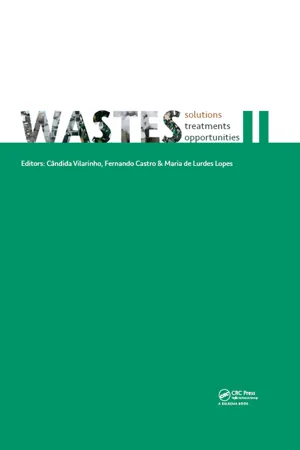
WASTES – Solutions, Treatments and Opportunities II
Selected Papers from the 4th Edition of the International Conference on Wastes: Solutions, Treatments and Opportunities, Porto, Portugal, 25-26 September 2017
- 452 pages
- English
- ePUB (mobile friendly)
- Available on iOS & Android
WASTES – Solutions, Treatments and Opportunities II
Selected Papers from the 4th Edition of the International Conference on Wastes: Solutions, Treatments and Opportunities, Porto, Portugal, 25-26 September 2017
About This Book
Wastes: Solutions, Treatments and Opportunities II contains selected papers presented at the 4th edition of the International Conference Wastes: Solutions, Treatments and Opportunities, that took place 25-26 September 2017 at the Faculty of Engineering of the University of Porto, Porto, Portugal.
The Wastes conference, which takes place biennially, is a prime forum for academics and industry representatives from the waste management and recycling sectors around the world to share their experience and knowledge with all in attendance.
The published papers focus on a wide range of topics, including: Wastes as construction materials, Wastes as fuels, Waste treatment technologies, MSW management, Recycling of wastes and materials recovery, Wastes from new materials (nanomaterials, electronics, composites, etc.), Environmental, economic and social aspects in waste management and Circular economy.
Frequently asked questions
Information
Table of contents
- Cover
- Half Title
- Title Page
- Copyright Page
- Table of Contents
- Preface
- Energetic recovery of municipal solid waste scenario in São Paulo State, Brazil
- Recycled synthetic waste fibres for the reinforcement of concrete
- Leaching characteristics of co-bearing glasses obtained from spent Li-ion batteries
- Valorisation of different wastes: A sustainable approach in the design of new products
- Belgian and Portuguese apple tree bark and core: Comparison of antioxidant content
- Process development for a combined treatment of EAFD and jarosite
- Mechanical damage of a nonwoven geotextile induced by recycled aggregates
- Smart biofilms produced from fish filleting wastes
- PAC and tannin as coagulants in swine slaughterhouse wastewater treatment
- Waste to energy as a complementary energy source in Abuja, Nigeria
- Study on properties related to energy recovery from waste streams in Finland
- Chars from co-gasification of rice wastes as Cr(III) removal agents
- Anaerobic digestion sludge composting—assessment of the star-up process
- Diagnosis and assessment of the management of sanitary landfill leachates in Portugal
- Truck tire pyrolysis optimization using the self-produced carbon black as a catalyst
- Waste cooking oils: Low-cost substrate for co-production of lipase and microbial lipids
- Proposal for MSW management facilities location in a state of Brazil
- Production of tannin-based adsorbents and their use for arsenic uptake from water
- Damage induced by recycled C&D wastes on the short-term tensile behaviour of a geogrid
- Lean-green synergy awareness: A Portuguese survey
- Efficiency of regeneration by solvent extraction for different types of waste oil
- Diethylketone and Cd pilot-scale biosorption by a biofilm supported on vermiculite
- Removal of wastewater treatment sludge by incineration
- Double benefit biodiesel produced from waste frying oils and animal fats
- Alkali-activated cement using slags and fly ash
- Waste of biodiesel production: Conversion of glycerol into biofuel additives
- Geotechnical characterization of recycled C&D wastes for use as trenches backfilling
- Recycling of MSWI fly ash in clay bricks—effect of washing and electrodialytic treatment
- Processing of metallurgical wastes with obtaining iron oxides nanopowders
- A step forward on cleaner production: Remanufacturing and interchangeability
- Review of potential ways for resource recovery from human urine
- Portugal lacks refuse derived fuel production from municipal solid waste
- Removal of Cr(III) from aqueous solutions by modified lignocellulosic waste
- Valorization of residues from fig processing industry by anaerobic digestion
- Hazards identification in waste collection systems: A case study
- Outlining strategies to improve eco-efficiency and efficiency performance
- Enzymatic esterification of pre-treated and untreated acid oil soapstock
- Formulation of waste mixtures towards effective composting: A case study
- Selective extraction of lithium from spent lithium-ion batteries
- The main environmental impacts of a university restaurant and the search for solutions
- Treatment of food waste from a university restaurant added to sugarcane bagasse
- Biosolids production and COD removal in activated sludge and moving bed biofilm reactors
- Anaerobic digestion impact on the adaptation to climate change in São Tomé and Príncipe
- Garden waste quantification using home composting on a model garden
- Acid esterification vs glycerolysis of acid oil soapstock for FFA reduction
- Sweet potato bioethanol purification using glycerol
- Methodology for the assessment of non-hazardous waste treatment areas
- MAESTRI efficiency framework as a support tool for industrial symbiosis implementation
- Activated carbons from Angolan wood wastes for the adsorption of MCPA pesticide
- Separate collection of packaging waste: Characterization and impacts
- Improvement of a clayey soil with alkaline activation of wastes
- Gasification of RDF from MSW—an overview
- Extraction of copper from dumps and tails of leaching by hydrochloric acid
- Construction wastes application for environmental protection
- Design of a laboratory scale circulating fluidized bed gasifier for residual biomass
- Efficient activated carbons from chars of the co-pyrolysis of rice wastes
- Recovery of the polymer content of electrical cables for thermal and acoustic insulation
- Recovery of wood dust in composite materials
- Modified biological sorbents from waste for the removal of metal ions from the water system
- Phytoremediation of soils contaminated with lead by Arundo donax L.
- Employment of industrial wastes as agents for inclusion modification in molten steels
- Olive pomace phenolics extraction: Conventional vs emergent methodologies
- Incorporation of metallurgical wastes as inorganic fillers in resins
- Sustainability and circular economy through PBL: Engineering students’ perceptions
- Suitability of agroindustrial residues for cellulose-based materials production
- Pyrolysis of lipid wastes under different atmospheres: Vacuum, nitrogen and methane
- Effect of temperature in RDF pyrolysis
- Potential of exhausted olive pomace for gasification
- Analysis of foundry sand for incorporation in asphalt mixtures
- Author index